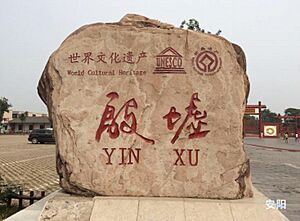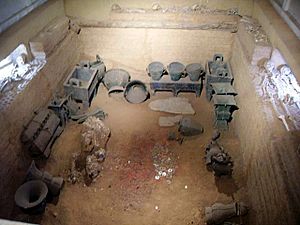History of Chinese archaeology facts for kids

Chinese archaeology is the study of ancient objects and sites in China. It helps us learn about China's long history. People in China have been interested in old artifacts for a very long time. This interest started during the Song dynasty (960–1279).
At first, it was more about collecting old art and studying ancient writings. Over time, especially in the early 1900s, Chinese archaeology became a modern science. It began to use new methods from around the world.
Contents
Exploring China's Past: A Look at Archaeology
Archaeology in China has changed a lot over time. We can divide its history into two main parts: traditional studies and modern scientific archaeology.
Early Discoveries: Traditional Epigraphy
During the Song dynasty (960–1279), smart people called scholar-officials became interested in old things. They were like early archaeologists. They collected ancient items, especially bronze vessels, from old sites. They wanted to use these old items in important government ceremonies.
Some scholars even tried to make new versions of these old bronze items. However, a famous scientist named Shen Kuo (1031–1095) thought this was wrong. He wrote in his book Dream Pool Essays that people should study the real objects. He believed these items were made by skilled workers, not by famous ancient leaders. Shen Kuo also thought archaeology should be about understanding how things worked and how they were made. He used old texts to figure out how ancient tools, like armillary spheres, were built.
Another scholar, Ouyang Xiu (1007–1072), studied old writings found on bronze and stone. He collected many copies of these writings. His work helped start the study of epigraphy, which is the study of ancient inscriptions.
Books were also made to list and describe these old finds. The Kaogutu (考古圖), published around 1092, was one of the first books to describe and sort ancient objects. Another big book was the Chong xiu Xuanhe bogutu, made between 1111 and 1125. It showed pictures of about 840 ancient vessels.
Song scholars also started to figure out how old artifacts were. They looked at the writings, decorations, and shapes of the objects. A scholar named Zhao Mingcheng (1081–1129) said that ancient writings could help correct mistakes in later history books.
After the Song dynasty, interest in these studies slowed down. It picked up again during the Qing dynasty (1644–1912). However, archaeology in China was mostly seen as part of history, not its own science, until modern times.
Modern Archaeology: New Ways of Studying the Past
Modern archaeology in China combines old Chinese traditions with new ideas from the West. It changed how people studied ancient China.
In the early 1900s, some historians started to question old Chinese history. A scholar named Fu Sinian (1896–1950) believed that archaeology could help solve these questions. He thought that digging up old objects could prove or disprove historical stories. He played a big role in the excavation of the Yin Ruins.
The excavations at the Yin Ruins helped train China's first modern archaeologists. These experts, like Li Ji (1896–1979) and Liang Siyong (1904–1954), learned modern archaeological methods from Western countries. They helped set up the first national archaeology group in China.
In 1916, the Geological Survey Institute was created. This group brought in foreign experts and trained Chinese scientists. They helped spread Western scientific knowledge in China.
In 1921, a Swedish scholar named Andersson discovered the Yangshao culture. He suggested that Chinese culture might have come from the West. While this idea was later mostly dropped, Andersson helped bring modern fieldwork and excavation methods to China.

In 1926, Li Ji led the first field excavation by Chinese scholars in Shanxi Province. Then, in 1928, the archaeological group started digging at the Yin Ruins.
A scholar named Wang Guowei (1877–1927) suggested using a "dual evidence method." This meant studying history by combining written documents with objects found underground. This method greatly improved how history and archaeology were studied.
In 1931, Liang Siyong led an important excavation at the Hougang site. He found different layers of ancient cultures. This showed that the Longshan culture was older than the Xiaotun culture but newer than the Yangshao culture. This helped archaeologists understand the timeline of early Chinese cultures.
See also



